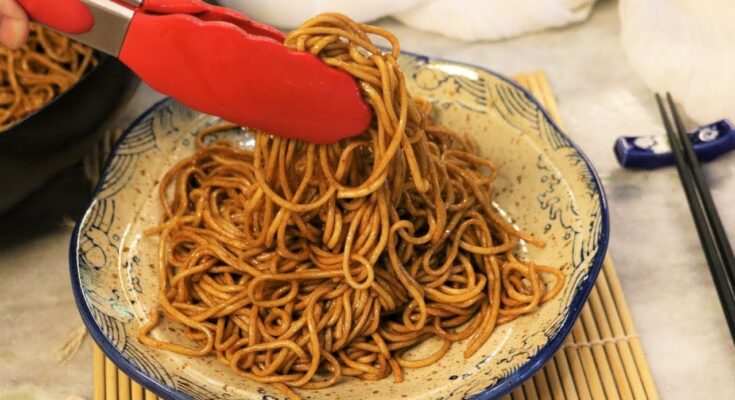Lo Mein Sauce Recipe: If you’ve ever craved a steaming plate of savory, slurpy, restaurant-style lo mein at home, you’re not alone. But here’s a secret: it’s all about the sauce. That glossy, flavorful coating that wraps itself around the noodles? That’s the magic you’re going to learn how to master right here, step by step.
What is Lo Mein?
Lo mein is a popular Chinese dish made with soft egg noodles tossed with vegetables, protein, and most importantly—a rich, umami-packed sauce. The name “lo mein” literally means “tossed noodles” in Cantonese, and that’s exactly what this dish is about. Unlike chow mein which often features crispy noodles, lo mein leans toward softness and succulence.
The dish is a staple in many Asian households and restaurants because it’s incredibly versatile. Whether you’re adding chicken, beef, tofu, or just loading it up with veggies, lo mein is a canvas—and the sauce is the paint. If your sauce is bland or too salty, it will overpower or underdeliver. That’s why nailing the perfect lo mein sauce is key to turning a good dish into an unforgettable one.
Why the Sauce Matters
The sauce is the soul of lo mein. It’s what ties together all the ingredients with a harmonious blend of salty, sweet, savory, and sometimes spicy elements. The right sauce doesn’t just sit on top—it soaks into the noodles, infuses the vegetables, and enhances the flavor of your proteins.
Most restaurant-style lo mein sauces rely on a few core ingredients—soy sauce for umami, sesame oil for nuttiness, a bit of sugar to balance, and some type of acid like rice vinegar. Getting the proportions right is crucial, but so is understanding how to build layers of flavor. Once you’ve mastered this sauce, you’ll never look at takeout the same way again.
Essential Ingredients for Lo Mein Sauce
Common Pantry Staples
The best part about making lo mein sauce at home? You likely already have most of the ingredients in your pantry. Here’s what you’ll need:
- Soy Sauce (2 types): Light soy sauce for saltiness and dark soy sauce for color and depth. These form the backbone of the sauce.
- Oyster Sauce: Adds richness and umami. It’s slightly sweet and thick, which gives the sauce its body.
- Sesame Oil: Just a few drops go a long way in delivering that nutty, toasty flavor.
- Garlic: Freshly minced garlic brings an aromatic punch.
- Brown Sugar or Honey: For a touch of sweetness that balances the salt and acid.
- Rice Vinegar or Shaoxing Wine: This gives the sauce its tang and helps cut through the richness.
Each ingredient has a role to play. Leave one out, and the sauce might taste flat or too one-dimensional.
Optional Add-ons for Extra Flavor
Depending on your preference, you can experiment with add-ons:
- Hoisin Sauce: If you want a slightly fruity undertone.
- Chili Garlic Paste or Sriracha: For those who love a spicy kick.
- Ground White Pepper: Adds mild heat and a distinct Chinese-style spice.
- Cornstarch Slurry: If you want a thicker sauce that clings to every noodle.
These extras allow you to personalize the flavor profile based on your taste or the kind of protein and vegetables you’re pairing the sauce with.
Equipment You’ll Need
Mixing Tools
Making lo mein sauce doesn’t require fancy tools, but having the right ones makes the process smoother:
- Small Mixing Bowl: A glass or stainless-steel bowl is perfect for whisking together your ingredients.
- Measuring Spoons & Cups: Precision is key, especially when dealing with salty and acidic ingredients.
- Whisk or Fork: To ensure the sugar dissolves properly and everything is well combined.
Consistency in preparation will ensure you get the same great taste every time.
Storage Containers
Once you’ve made your lo mein sauce, it can be stored for later use:
- Airtight Glass Jars or Bottles: Glass is ideal because it doesn’t absorb odors and keeps the sauce fresh longer.
- Label and Date: Always label your homemade sauces with the date. Most can last in the fridge for up to 7 days.
Having the sauce ready to go means you’re always just minutes away from a satisfying meal.
Step-by-Step Lo Mein Sauce Recipe
Step 1: Gather All Ingredients
Before you start mixing, lay everything out. Here’s a basic recipe for one batch (enough for 2-3 servings):
- 2 tablespoons light soy sauce
- 1 tablespoon dark soy sauce
- 1 tablespoon oyster sauce
- 1 teaspoon sesame oil
- 1 teaspoon rice vinegar or Shaoxing wine
- 1 tablespoon brown sugar
- 2 cloves garlic, minced
Want to go spicy? Add 1 teaspoon of chili garlic sauce. Looking for a thicker texture? Mix 1 teaspoon cornstarch with 1 tablespoon water and add it in.
Step 2: Measure with Precision
Don’t eyeball it—especially when you’re starting out. Use measuring spoons to ensure your ratios are spot-on. The balance between salty, sweet, and sour is delicate, and small changes can make a big difference.
Measure all the liquids first and pour them into the mixing bowl. Then add the minced garlic and sugar.
Step 3: Mix to Perfection
Use a whisk or fork to thoroughly combine all the ingredients. You want the sugar to fully dissolve and the garlic to distribute evenly. Taste your sauce—if it’s too salty, add a dash more vinegar or sugar. Too sweet? Add a drop more soy sauce.
Once mixed, you can either use it immediately or store it in a jar in the refrigerator for up to a week.
Customizing Your Lo Mein Sauce
Make It Spicy
Spicy lo mein is a favorite for those who enjoy a little heat with their noodles. The beauty of making your own lo mein sauce at home is that you control the spice level. You’re not stuck with “mild” or “extra hot” based on a restaurant’s interpretation. Here’s how to bring the fire:
- Chili Garlic Sauce: This is the most commonly used spicy addition. It’s readily available in most grocery stores and adds both heat and garlicky depth.
- Sriracha: A more tangy, slightly sweet option that blends seamlessly with lo mein sauce ingredients.
- Crushed Red Pepper Flakes: These offer a dry heat and can be infused into the sauce while it’s being mixed or cooked.
- Fresh Chili Peppers: If you’re feeling bold, finely chopped Thai bird’s eye chilies or jalapeños can give your sauce an immediate spicy upgrade.
Start small and increase to taste—remember, you can always add more, but you can’t take it out once it’s mixed. The spicy version of this sauce pairs especially well with proteins like shrimp or beef and crunchy vegetables like bell peppers and snap peas. It creates a depth of flavor that balances with the sweet and savory elements, making every bite an adventure for your taste buds.
Make It Sweet
Some people prefer a sweeter undertone in their lo mein, especially if they’re pairing it with milder proteins like chicken or tofu. Sweet lo mein sauce doesn’t mean sugary or dessert-like—it just means the balance tips a little toward the caramelized flavor side. Here’s how to achieve that:
- Brown Sugar: Already part of the classic recipe, but you can slightly increase the quantity to bring out the sweet notes.
- Honey or Maple Syrup: These natural sweeteners add a more complex flavor compared to plain sugar.
- Hoisin Sauce: A thick, sweet, and salty sauce that blends well and adds a lovely glaze to the noodles.
Just like with spice, sweetness should be adjusted slowly. Sweet lo mein is great for kids or those with milder palates, and it’s fantastic with veggies like broccoli, carrots, and snow peas, which naturally lean toward the sweet side when cooked.
Make It Vegan
Want to skip the animal-based ingredients without sacrificing flavor? Lo mein sauce is incredibly easy to veganize. Most of the core ingredients are plant-based, but one big exception is oyster sauce. Here’s how to work around that:
- Use Mushroom Stir-Fry Sauce: This is a common vegan alternative to oyster sauce. It has that deep, umami-rich flavor from mushrooms and works beautifully in lo mein sauce.
- Soy Sauce + Hoisin Combo: Hoisin sauce is usually vegan and can mimic some of the thickness and sweetness of oyster sauce.
- Liquid Aminos or Tamari: These are great soy sauce alternatives if you’re also gluten-free. They bring the salt and umami without compromising dietary restrictions.
Vegan lo mein sauce can be just as flavorful, especially when paired with tofu, tempeh, or an array of vibrant, crunchy vegetables. Don’t forget to add a splash of sesame oil and fresh garlic to keep it aromatic and satisfying.
Tips for Cooking with Lo Mein Sauce
Once your sauce is ready, using it correctly in the dish is just as important. Here are some pro tips:
- Add the Sauce Last: Cook your noodles and vegetables first, then pour the sauce over at the end. This helps prevent burning or over-reduction.
- Don’t Overcook: Once the sauce hits the hot pan, it’ll reduce quickly. Toss everything thoroughly to coat, and remove from heat within a minute or two.
- Taste Before Serving: Always give it a final taste. Need more sweetness? A touch more sugar. Too salty? A splash of water or vinegar can balance it out.
Using these cooking techniques ensures that your lo mein dish tastes like it came from your favorite Chinese restaurant—even better, it’s tailored to your exact preferences.
Storing and Reusing Lo Mein Sauce
Refrigeration and Shelf Life
One of the best parts about making lo mein sauce at home is that you can make a large batch and store it for future meals. If you’re cooking for a busy household or like to meal prep, this sauce is a time-saving hero.
Once you’ve made your sauce, pour it into a clean, airtight glass jar or bottle. Glass is preferred because it doesn’t absorb odors or stain from ingredients like soy sauce or garlic. Label your container with the date, and store it in the refrigerator. Properly stored, homemade lo mein sauce can last for up to 7 days.
Make sure to shake or stir the sauce before each use since ingredients like garlic or sugar may settle at the bottom. If the sauce thickens too much in the fridge, you can loosen it up with a splash of warm water before adding it to your dish.
Freezing the Sauce
Want to store it longer? You can freeze lo mein sauce. Pour it into silicone ice cube trays, freeze, then pop the cubes out into a freezer-safe zip-lock bag. This way, you can take out only what you need. Frozen lo mein sauce is best used within 2-3 months for optimal flavor.
When ready to use, thaw in the fridge overnight or warm it gently in a saucepan. It’ll taste just as fresh as the day you made it.
Best Noodle and Protein Pairings for Your Sauce
Noodle Options
While the sauce is undoubtedly the star, the noodles are your supporting cast. Choosing the right type of noodle can elevate your dish from good to gourmet:
- Egg Noodles: These are the traditional choice. Their soft, slightly chewy texture holds sauce beautifully.
- Ramen Noodles: A great substitute if you’re out of egg noodles—just skip the seasoning packet.
- Spaghetti or Linguine: Yes, Western pasta can work too! It absorbs sauce well and has a similar texture.
- Rice Noodles: Ideal for gluten-free diets. Choose medium-width noodles for the best results.
Always cook your noodles until just tender (al dente) so they don’t turn mushy when stir-fried.
Protein Pairings
This sauce is incredibly versatile, meaning it works with a variety of proteins. Here’s how to pair:
- Chicken: Thinly sliced chicken breast or thigh soaks up the sauce and remains tender.
- Beef: Flank steak or sirloin, cut against the grain, gives you a juicy and flavorful bite.
- Shrimp: A quick sauté and the shrimp is ready to bathe in that savory sauce.
- Tofu: Firm tofu, pan-fried to golden, acts like a sponge for all that umami goodness.
- Eggs: Scrambled eggs or an over-easy fried egg on top adds richness.
Each protein adds a different vibe to the dish, making it perfect for whatever you’re craving that day.
Serving Suggestions for Homemade Lo Mein
Homemade lo mein is a meal in itself, but pairing it with complementary sides and toppings can turn it into a feast:
- Vegetable Spring Rolls: Crunchy, fresh, and the perfect appetizer to start your meal.
- Hot and Sour Soup or Egg Drop Soup: A light soup balances out the richness of the noodles.
- Steamed Dumplings: Add another layer of texture and flavor to your dinner.
- Fresh Herbs: Garnish with scallions, cilantro, or even a sprinkle of toasted sesame seeds.
- Lime Wedges or Pickled Veggies: A touch of acidity to brighten up each bite.
These extras bring variety and fun to the table, making even a weekday dinner feel like a celebration.
FAQs about Lo Mein Sauce Recipe
Q1: Can I make lo mein sauce without soy sauce?
Yes! You can substitute soy sauce with tamari or coconut aminos for a lower-sodium or gluten-free alternative. Just adjust other seasonings to taste.
Q2: Is lo mein sauce the same as chow mein sauce?
Not exactly. While similar in ingredients, lo mein sauce is generally lighter and more saucy, whereas chow mein sauce is often thicker and used with crispy noodles.
Q3: How can I make my lo mein sauce thicker?
Add a cornstarch slurry (1 tsp cornstarch mixed with 1 tbsp water) while heating the sauce. It will thicken as it simmers.
Q4: What vegetables go best with lo mein?
Bell peppers, carrots, broccoli, cabbage, snap peas, and mushrooms are all excellent choices. Aim for a colorful mix for visual appeal and nutrition.
Q5: Can I double or triple the recipe for meal prep?
Absolutely! Just multiply the ingredients accordingly and store the sauce in a clean, airtight jar in the fridge or freezer.
Conclusion
There’s something deeply satisfying about recreating your favorite takeout dish at home—and with this lo mein sauce recipe, you’re not just mimicking it; you’re mastering it. From the savory umami punch of soy and oyster sauce to the personalized twist of spice, sweetness, or vegan tweaks, this sauce is your ticket to an unforgettable dish every single time.
Whether you’re cooking for yourself, your family, or hosting friends, homemade lo mein with your signature sauce will always be a hit. So go ahead—mix up a batch, toss it with your favorite noodles and proteins, and watch the compliments roll in.



